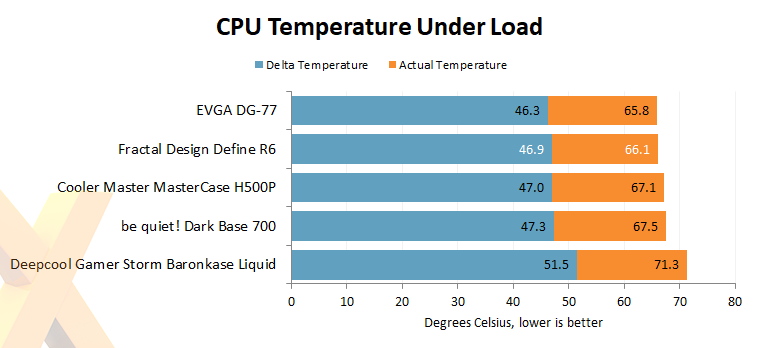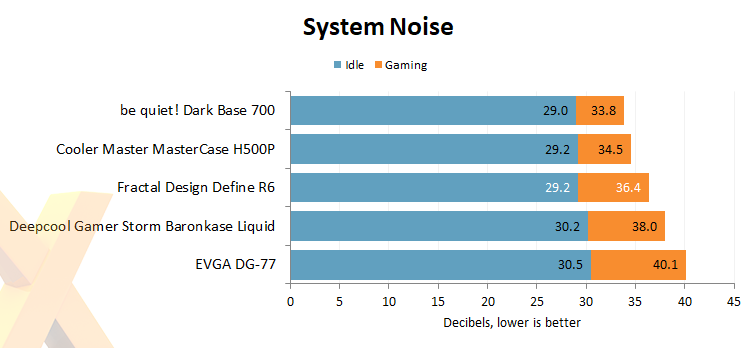Test Methodology and Performance
Comparison Chassis |
||||
|---|---|---|---|---|
| Chassis | Form Factor | HEXUS Review | Reviewed Price | Product Page |
| be quiet! Dark Base 700 | Mid-tower | November 2017 | £175 | bequiet.com |
| Cooler Master MasterCase H500P | Mid-tower | October 2017 | £150 | coolermaster.com |
| Deepcool Gamer Storm Baronkase Liquid | Mid-tower | December 2017 | £125 | gamerstorm.com |
| EVGA DG-77 | Mid-tower | December 2017 | £140 | evga.com |
| Fractal Design Define R6 | Mid-tower | December 2017 | £135 | fractal-design.com |
HEXUS Chassis Test Bench |
|||
|---|---|---|---|
| Hardware Components | HEXUS Review | Product Page | |
| Processor | AMD Ryzen 7 1800X | March 2017 | amd.com |
| CPU Cooler | Fractal Design Celsius S24 | May 2017 | fractal-design.com |
| Motherboard | MSI X370 XPower Gaming Titanium | - | msi.com |
| Memory | G.Skill Flare X 16GB DDR4-2400 | May 2017 | gskill.com |
| Graphics Card | Sapphire Radeon RX 580 Nitro+ Limited Edition | April 2017 | sapphiretech.com |
| Power Supply | be quiet! Dark Power Pro 11 (750W) | May 2015 | bequiet.com |
| Storage Device | Corsair 240GB Force Series MP500 M.2 SSD | - | corsair.com |
| Monitor | iiyama ProLite X4071UHSU-B1 | January 2016 | iiyama.com |
| Operating System | Windows 10 (64-bit) | - | microsoft.com |
Notes
The time has come to overhaul our chassis test platform with modern components. Our trusty Intel Core i5-3570K processor and dual GeForce GTX 970 graphics cards have been retired from service, and in comes an all-AMD combination of Ryzen 7 1800X and Radeon RX 580.
AMD's eight-core, 16-thread processor is stock clocked (our chip struggled with stability when aiming for over 4GHz across all cores) and installed beneath a Fractal Design Celsius S24 liquid cooler. The CPU is joined by 16GB of G.Skill Flare X DDR4 memory operating at 2,400MHz, while the Radeon RX 580 GPU is provided by Sapphire in Nitro+ Limited Edition guise. Power for the entire system comes courtesy of a 750W be quiet! Dark Power Pro 11 supply. Do note that we attempted to run multiple memory kits at higher speeds, but were unable to maintain stability on this particular X370 platform, hence the 3,200MHz G.Skill kit operating at 800MHz less than advertised.
To find out how well the comparison chassis can cool the AMD-flavoured build, we log CPU temperature while encoding a large 4K video clip using the popular HandBrake software utility. This task puts heavy load on all available CPU cores and we extend the stress test by queueing multiple passes. In order to provide a stabilised reading we then calculate an average temperature from the last few minutes of encoding.
To get an idea of graphics-card cooling performance, we log GPU temperature while looping the F1 2017 benchmark at a 4K resolution with ultra quality settings. Last but not least, we also measure chassis noise by using a PCE-318 noise meter to take readings both when idle and while gaming. The meter is positioned 35cm from the front of the chassis in a direct line of sight 30cm from the ground.
All chassis are tested only with the standard manufacturer-supplied fans (any/all of which are set to a low-noise curve in the MSI BIOS or low-speed using a fan controller if present), and to take into account the fluctuating ambient temperature, our graphs depict both actual and delta temperature - the latter is the actual CPU/GPU temperature minus the ambient.
Performance

Is a chassis going to make a great deal of difference when it comes to liquid-cooling a modern CPU? The four enclosures tested with our 240mm Celsius S24 cooler suggest not; they all have no trouble taming our eight-core chip.

Graphics cooling tends to reveal more interesting results. The above graph depicts the Define R6 with the vertical GPU mount, but it is worth noting that the Radeon RX 580 ran a fraction cooler when mounted horizontally.

The same holds true for noise levels. Define R6 proved very quiet with our test platform idling, but noise levels when gaming rise according to orientation. With the graphics card close up to the glass, our noise meter recorded 36.4dB, switching to a more traditional horizontal orientation reduced system-wide noise to 35dB.


